We wish to explore the poem Eldorado by Edgar Allan Poe via an analysis. First, we will give a brief summary. Second, we will provide some historical background. Third, we’ll go through the poem, Eldorado, almost line by line—making some specific points regarding metaphors, imagery, and symbols. We’ll also explore the meter and rhymes of the poem. Finally, we’ll discuss possible interpretations and meanings as a final summary.
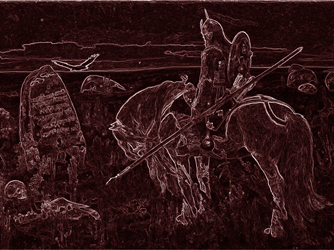
Eldorado Summary
The poem Eldorado by Edgar Allan Poe is a very short poem. It is only fours stanzas, and each stanza is less than thirty words making up six lines. We are introduced to a “gallant knight” in the first stanza. This knight is on a quest to find Eldorado, a place we’re given no information about. In the second stanza we learn that the knight has fallen onto hard times, for so far, he has failed in his quest. In the third stanza, the knight’s strength has entirely failed him. However, he comes across an enigmatic “pilgrim shadow”. The knight asks this “pilgrim shadow” for the location of Eldorado. In the fourth stanza, the shadow does not directly answer the question, instead he urges the knight on onwards into even greater perils. Then, the poem ends.
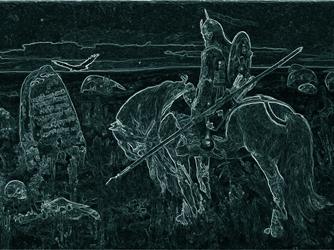
Eldorado Historical Background
Eldorado meaning:
The term literally means in Spanish, something like “The Gilded One” or “The Golden One”. “El Dorado” also relates to a legendary city of gold hidden deep in South America. Famous Spanish conquistadors such as Francisco de Orellana and Gonzalo Pizarro tried to find this city.
This search was not confined to just the Spanish. Sir Walter Raleigh, the famous English explorer also tried to find the city. All of these explorers failed. While at first many believed in the existence of the city, this belief began to fade somewhat by the early 1800s when the famous Prussian naturalist Alexander von Humbolt claimed to have definitively proved the city was merely myth. It’s clear from references in Edgar Allan Poe’s work that he was both familiar with and had read some of Humbolt’s writings. Poe even dedicated his famous prose poem, Eureka, to Humbolt.
Eldorado and the gold rush:
In 1848 gold was discovered in California, which over the next several years led to a massive gold rush. The county where the initial gold was found in California is now called, El Dorado. This is not a mere coincidence. Very quickly in the public’s imagination the California gold rush became tied up with the legendary city of gold, El Dorado. It’s clear that people saw the excitement being generated as a new incarnation of the old legend. Yet, just as no one ever discovered the fabled city of gold, in actuality, most of those pursuing gold in California did not get rich either. Edgar Allan Poe was well aware of all of this.
“El Dorado” in Poe’s other writings:
Having mentioned the gold rush above—we must caution readers of the poem to be careful, because clearly Poe had become accustomed to using the term “El Dorado” well before the gold rush ever began. One example of this is in a published letter of Poe’s in a literary magazine in 1836. The letter is titled, “Letter to B–“. In this letter, Poe uses to term, “El Dorado” figuratively to suggest an idealized goal — specifically it is described as a sort of idealized feeling that a poet seeks.
Poe uses the term, again figuratively, in 1844 in the poem, Dream-Land:
For the heart whose woes are legion
’T is a peaceful, soothing region —
For the spirit that walks in shadow
’T is — oh ’t is an Eldorado!
So, clearly Poe at times used the term merely in a figurative sense, as an idealized place. Notably in Dream-Land as an idealized place that can be contrasted with shadow.
Poe’s attitude toward the gold rush:
In various places from letters to stories, Poe can be found referencing the California gold rush. For example, in Poe’s story, Von Kemplelen and His Discovery, Poe tries to poke fun at those involved in the gold rush. His story is written as a sort of prank that suggests that a means of changing lead into gold has been discovered. He wanted the letter to fool at least some of the people, and even expressed the hope that perhaps it might act as a “very temporary check to the gold-fever.”
Another very relevant place where Poe brings the topic up is in a letter to his friend, Frederick W. Thomas. We should quote Poe in full:
I shall be a litterateur, at least, all my life; nor would I abandon the hopes which still lead me on for all the gold in California. Talking of gold, and of the temptations at present held out to “poor-devil authors”, did it ever strike you that all which is really valuable to a man of letters — to a poet in especial — is absolutely unpurchaseable? Love, fame, the dominion of intellect, the consciousness of power, the thrilling sense of beauty, the free air of Heaven, exercise of body & mind, with the physical and moral health which result — these and such as these are really all that a poet cares for: — then answer me this — why should he go to California? Like Brutus, “I pause for a reply” —
We gather from all this that Poe did not think highly of “gold fever” and that he saw the pursuit of gold as materialistic.
Poe’s life at the time of the poem:
The poem Eldorado was written in the last year of Poe’s life and published on April 21, 1849. Poe would die in October of that same year. At the time, he was pursuing a lot of different goals, many of which seemed to thwart him.
In a deeply personal letter, perhaps written only a month or two after he’d penned the poem Eldorado, Poe describes his repeated failures to a confident of his, but adds:
No doubt, Annie, you attribute my “gloom” to these events — but you would be wrong. It is not in the power of any mere worldly considerations, such as these, to depress me…. No, my sadness is unaccountable, and this makes me the more sad. I am full of dark forebodings. Nothing cheers or comforts me. My life seems wasted — the future looks a dreary blank: but I will struggle on and “hope against hope.”
Here we can note that despite Poe’s inexplicable gloom, he is determined to push onwards toward his goals—his own personal Eldorado.

Walkthrough of Eldorado by Edgar Allan Poe
Here we will provide each stanza and then make some points about that stanza. Each of these points should be regarded as separate from the others. We draw conclusions from these different points only in the final section of this analysis.
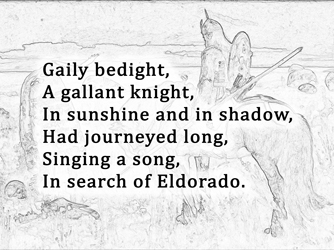
• The first stanza is merely twenty words. It contains a rhyming structure as follows: lines one and two rhyme; lines three and six rhyme; and lines four and five rhyme. Using letters we can demonstrate this as aabccb. With the exception of the third and six line, each line is only four syllables. The third and sixth line are each seven syllables. Stanza two and three will follow an identical pattern.
• “Shadow” and “Eldorado” are paired up via rhyme throughout the entire poem. “Eldorado” is something bright as contrasted with the word “shadow.”
• The first stanza is relatively upbeat. The knight is dressed “gaily” as if going on an outing. He is described as “gallant”. Yes, there is “shadow” present but only as a complement to “sunlight”. Despite that the knight has journeyed long, he is still “singing a song”. There is a strong sense of optimism in this verse.
• This stanza conjures up mythical, idealistic, perhaps even magical images. One can easily be reminded of the quest for the Holy Grail. So despite the brevity of this stanza, because it calls upon cultural archetypes, we’re able to see the knight’s quest here as something epic.
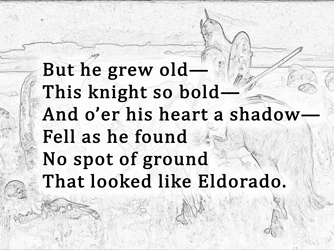
• The second stanza is twenty six words, and it follows the same rhyming structure as the first stanza above, aabccb. It is also metered in the same manner.
• Despite the stanza’s brevity, we go from the grand sense of optimism projected in the first stanza, to one here, that is full of threatening gloom. The knight is old; a shadow has been cast over his heart; he has failed his quest; he can’t find Eldorado anywhere. A despondent picture is painted.
• Note the darker use of shadow here. It’s no longer a complement for sunlight, but instead something cast over the heart—a negative influence. It’s almost like a cancer, and one fears what it might do.
• The second stanza is suspenseful. The knight is still bold. However impossible it might be, we still want the knight to achieve his goal. So we are really drawn in here, and have to ask, what will happen next? Again, because of the archetypal nature of the images and metaphors used here, Poe can really draw us in.
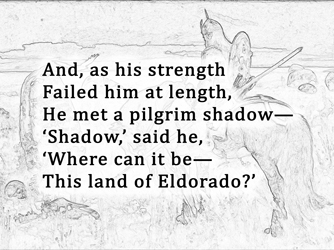
• The third stanza is twenty four words. And again it follows the rhyming structure, aabccb.
• The sense of gloom that descended upon the second stanza is not alleviated here—in fact, it nearly reaches a point of completion, the knights strength has totally failed—but then a twist is thrown in to prevent the total descent into despair.
• The use of the word shadow here takes on yet another meaning, and the word is used twice. We will discuss this more below, but we think there are many different ways to look at the use of the word shadow here. One of them is as the past exerting its influence today but only indirectly—the way a shadow is only indirectly like its object. In this manner, the term takes on possible Platonic implications—and we are reminded of the Allegory of the Cave.
• The use of the word pilgrim conveys a seeker of truth. It is a positive and optimistic image. The pilgrim is perhaps not unlike the knight. A pilgrim is on a journey toward an ultimate destination. Is not the knight situation then, identical? If this pilgrim is merely a shadow, then perhaps it represents that they are only a figure from the past, reaching forward into the future via their legacy. This pilgrim, perhaps, is only present in spirit.
• This poem reads as a suspenseful story. We start out in the first stanza with a noble goal, then in the second stanza we learn the quest might fail. As we enter the third stanza, we’re almost sure this failure is immanent, yet the pilgrim knight comes along and offers perhaps a hairsbreadth of hope. So the suspense continues …
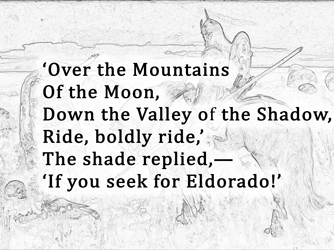
• The last stanza is twenty three words. The rhyme structure is slightly altered in that the first two lines no longer rhyme. Also, we would expect the second line to be four syllables but instead it is three. It would seem this lost syllable goes to the third line—which is eight syllables instead of seven. If you look at the word “down”, that is the word that could have been put in the second line, but really wouldn’t have fit … also, “down” almost does rhyme with mountain. Why did Poe make this choice, and break the pattern set forth in the other stanzas is hard to say. Was it intentional? If so, then why?
• The reference to “the Mountains of the Moon” is very much like the reference to Eldorado. It’s a mysterious place that some claimed existed, but no one could ever confirm. The legend in this case was much older having existed since ancient times. A merchant Diogenes claimed to have been taken to the source of the Nile, and there he had scene what he described as “the Mountains of the Moon”. In Poe’s time no one had yet to have discovered these mountains—and probably many took them to be only legends.
• The moon here contains potential symbolism. The moon is a light in the shadow. It lights up the night. Also it is cyclical and eternal.
• “The Valley of the Shadow” would seem to be a clear reference to the bible, Psalms, chapter 23, verse 4, which reads, “Yea, though I walk through the valley of the shadow of death, I will fear no evil.” This psalm also famously says, “The Lord is my shepherd …” and in a sense is about both guidance and comfort.
• It’s important to note here that the question from the third stanza has not really been answered. The knight had asked where the land of Eldorado is, however, instead of an answer, the knight is simply given some enigmatic instructions—that he can’t really be expected to follow.

Eldorado Interpretations
Is Eldorado merely a poem about death?
Some analyses of Eldorado by Edgar Allan Poe argue the poem’s theme is primarily about death. This interpretation of the poem suggests that Eldorado represents certain ideals that can only be attained via death. While the knight has still not managed to obtain his ideals, by pursuing them unto his death, he can at last obtain them. The argument here is that the “pilgrim shadow” is perhaps a harbinger of death—or perhaps even Charon, a guide—and that now it is time for the knight to die. “The Mountain of the Moon” are a metaphor for passing into the after life, and the “the Valley of the Shadow” is a metaphor for death. We find this interpretation interesting, yet unsatisfactory. It comes near to making suggestions about the afterlife—and yet we don’t think the poem is really about the afterlife. We think instead, it is about how to live life.
Is Eldorado a poem about the stages of our lives?
Another interpretation of the poem suggests that this poem follows a pattern not dissimilar to another Edgar Allan Poe poem, “the Bells” where each stanza represents a stage in one’s life. Here the suggestion is that the first stanza represents youth, when all is brightness and glory. The second stanza represents middle-age, where not only does our strength begin to fade, but our naïve belief in ideals, as well. The third stanza is then to represent our final years before we cross over—and here too the “pilgrim shadow” represents our guide into death. The final stanza then represents death—which the knight meets with great boldness. We reject this interpretation as well—it strikes us as too contrived and void of any emotional depth. The poem would seem without any import via this interpretation. It would be like saying, a brave man lived, and then he died—the end. We think there is more that meets the eye going on here.
What lies behind the reference to “The Valley of the Shadow” in Eldorado?
We want to note some key things that we don’t feel the above analyses takes into account. First, there is the reference to Psalm 23, verse 4. We feel it is an error to regard “the valley of the Shadow” as death. Psalm 23 is for the living—to give the living hope when they fear death. The “pilgrim shadow” urges the knight to boldly ride into this valley, yet surely this “pilgrim shadow” is not suggesting the knight must die to obtain Eldorado, but instead, suggesting that the knight must not fear death in the pursuit of Eldorado. Note the knight was on the point of dying, so should he give up? The “pilgrim shadow” is saying, don’t fear that particular eventuality, instead just continue to pursue your quest.
Who does the “pilgrim shadow” represent in the poem Eldorado?
We’ve alluded to this already in our line by line analysis, but we will go into a more detail here. Have you ever heard the expression “the shadow of the past”? This expression can be found in literary vogue before 1849, the year Edgar Allan Poe wrote Eldorado. The expression suggest that the past is still with us, influencing the present. We can see the past via this influence, yet only as clearly as one sees a shadow. Yes, perhaps the “pilgrim shadow” is a ghost, but an emphasis on his incorporeality misses the point. This is a pilgrim from the past, whose influence is still being felt today—this is why he is only shadowy. What type of pilgrims from the past influence people today? Why poets and writers like Edgar Allan Poe, of course. The shadow represents those who have gone before the knight on this very same quest, and they are reaching out with a message for the knight. Don’t give up—keep the quest alive!
What’s the Allegory of the Cave? What does Eldorado have to do with Plato?
In Plato’s the Republic, book VII, he describes a famous scenario which has become known as the Allegory of the Cave. It’s basically an ancient version the Matrix, where virtual reality is represented as shadows. Plato describes an odd situation, where prisoners are chained up in just such a way that they are all forced to stare at a cave wall in front of them. Behind them there is a fire burning. Now between the prisoners and the fire there is a raised walkway. Across this walkway pass all the ordinary activities of life—people going to trade goods, animals, and so on. The prisoners begin to make some sense of these shadows—and to a degree they think they even understand them. But imagine that one of the prisoners breaks free of his chains, and actually gets to see beyond the shadows?
Note the use of the word shadow here. Here “shadow” represents false images, the way the Matrix represents a false view of life in modern parlance. Given that Poe was acquainted with the classics, he was probably well aware of this reference. So when he gives us a poem using shadow in several different ways, we can suggest something similar is going on here, not unlike the Matrix. A shadow can represent an aspect of reality, that is not actual reality.
A shallow quest for gold is a shadow of what life’s real quest is, the quest for a meaningful life. A shadow crosses the pilgrims heart when he realizes that he’s put all his hopes on obtaining something he might never obtain. Will his life then be without meaning? But then is it a meaningful life that the knight really wanted all along—not to find Eldorado? The problem here turns from one of finding the famed city of Eldorado to one of finding meaning in one’s life—so by the time we arrive at the third stanza an important transition has begun to take place.

The meaning of Eldorado
We feel that when the knight starts his search for Eldorado, he is looking for some tangible location that will fulfill his goals. Yet, what he learns on this quest, is that the journey itself carried out with integrity, is itself his goal—and therefore his Eldorado. To spell this out as clearly as possible. Eldorado is at first a fairly shallow goal—like to slay a dragon and take its treasure, or to go off to California and get rich, or to achieve fame. However, by the end of the poem, it’s learned that these goals can’t ever be achieved in such a manner that they bring what the heart desires. Instead, what the heart desires is a meaningful existence—and this is something that can only by obtained by pursuing the quest—not in completing it.
Consider the Wizard of Oz by L. Frank Baum. Each of Dorothy’s companions start the journey looking for a tangible goal. The Scarecrow wants a brain, the Tin Woodman wants a heart, and The Lion wants courages. On the road to find these things, the Scarecrow proves his wit, the Tin Woodman his ability to care, and the Lion his ability to be bold. The journey itself provides them with precisely that which they sought—but in a tangible sense can’t ever really achieve. It is the same with the journey this knight has embarked upon.
Think of it in terms of the search for a meaningful life. We start out with fairly shallow goals, would any of these goals actually make us happy? Maybe, but then again maybe not. It’s not really the attainment of goal itself that gives us meaning, it’s having a goal before us to attain. Eldorado provides meaning only so long as we pursue it, but not if we were to find it. They are the stars by which we navigate our boat though we never actually sail to them.
This is why the figure of the “pilgrim shadow” is important. He is the voice of the past, explaining to the knight the real meaning of the quest is not the goal, but the quest itself. He doesn’t at all tell the knight to give up—he gives him an even more nebulous, difficult, intangible goal. He must journey to the famed “Mountains of the Moon”—but even if this leads the knight toward the threat of death, he must not fear, because in pursuing such goals, he’ll find his real Eldorado, the meaning the knight obtains from the quest itself.

We hope you enjoyed our analysis. Don’t forget to subscribe to our poetry updates.